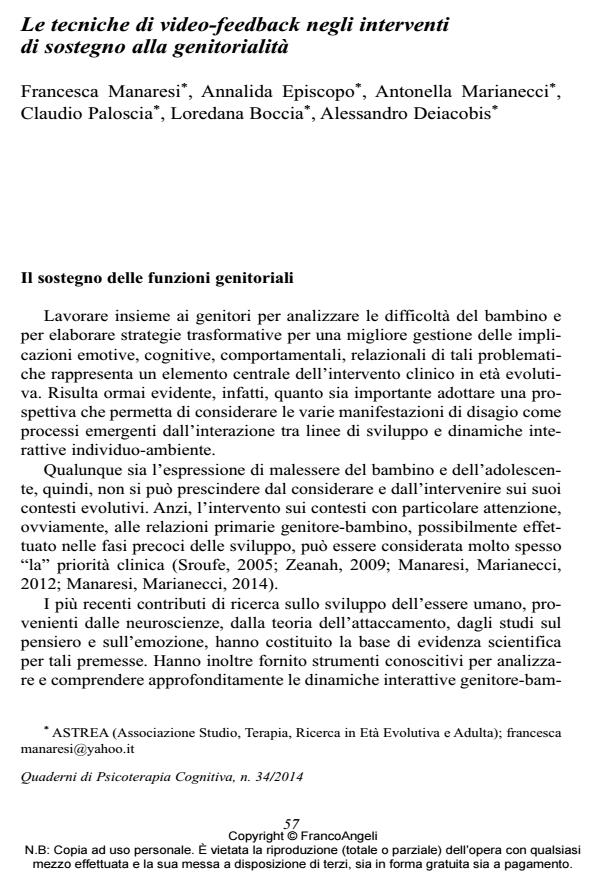Le tecniche di video-feedback negli interventi di sostegno alla genitorialità
Titolo Rivista QUADERNI DI PSICOTERAPIA COGNITIVA
Autori/Curatori Francesca Manaresi, Annalida Episcopo, Antonella Marianecci, Claudio Paloscia, Loredana Boccia, Alessandro Deiacobis
Anno di pubblicazione 2014 Fascicolo 2014/34
Lingua Italiano Numero pagine 22 P. 57-78 Dimensione file 215 KB
DOI 10.3280/QPC2014-034005
Il DOI è il codice a barre della proprietà intellettuale: per saperne di più
clicca qui
Qui sotto puoi vedere in anteprima la prima pagina di questo articolo.
Se questo articolo ti interessa, lo puoi acquistare (e scaricare in formato pdf) seguendo le facili indicazioni per acquistare il download credit. Acquista Download Credits per scaricare questo Articolo in formato PDF

FrancoAngeli è membro della Publishers International Linking Association, Inc (PILA)associazione indipendente e non profit per facilitare (attraverso i servizi tecnologici implementati da CrossRef.org) l’accesso degli studiosi ai contenuti digitali nelle pubblicazioni professionali e scientifiche
Il modo in cui i genitori si prendono cura del proprio bambino esercita un’influenza significativa sul suo sviluppo emotivo, cognitivo, comportamentale e relazionale. Gli studi sui primi mesi di vita, attraverso sofisticate tecniche di videoriprese e di microanalisi dei filmati, hanno permesso di mettere in risalto l’influenza delle dinamiche interattive precoci sui processi di regolazione emotiva così importanti per lo sviluppo dell’individuo. Il riferimento a dati e a tecniche di ricerca e a un approccio multidisciplinare caratterizza la maggior parte dei modelli di intervento clinico sulle funzioni genitoriali. In questo ambito, infatti, i clinici sono chiamati a una valutazione molto accurata delle problematiche considerando in modo integrato tutte le dimensioni implicate (psicologiche, relazionali, e sociali) per organizzare interventi efficaci che rispettino di volta in volta specifiche priorità e risorse a disponibili. L’uso dei video e la tecnica del video-feedback costituisce ormai una prassi consolidata ed efficace nel lavoro clinico sulle funzioni genitoriali che fa riferimento alla teoria dell’attaccamento. Poter considerare anche altri assetti motivazionali permette di comprendere come i processi di regolazione dell’attivazione emotiva, le funzioni cognitive, i sistemi comportamentali entrino in gioco negli scambi relazionali nel corso dello sviluppo. Il lavoro con il video-feedback in questo caso aiuta i genitori a riconoscere gli aspetti centrali delle dinamiche motivazionali attive nei processi relazionali genitori-figli e consente di migliorare la capacita di gestire in modo adeguato le diverse attivazioni emotive, cognitive, comportamentali proprie e del bambino.
Parole chiave:Genitorialità, interventi con prove di efficacia clinica in età evolutiva, tecniche di video-feedback, sistemi motivazionali interpersonali.
Francesca Manaresi, Annalida Episcopo, Antonella Marianecci, Claudio Paloscia, Loredana Boccia, Alessandro Deiacobis, Le tecniche di video-feedback negli interventi di sostegno alla genitorialità in "QUADERNI DI PSICOTERAPIA COGNITIVA" 34/2014, pp 57-78, DOI: 10.3280/QPC2014-034005